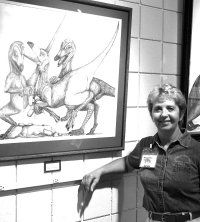| Denise Thayn, CEU museum staff artist, is pictured with one of nine new paintings of dinosaurs found in the area within the last 10 years. An exhbiit features her work, along with many other artists and will be on display throughout September. |
It is the first time most of these art pieces have ever been on display and if one thinks about it, the exhibit, that is currently being featured at the CEU Prehistoric Museum art gallery has been in the planning stage for the past 30 years.
Ironically it’s a dinosaur (and prehistoric beasts) exhibit and features all the artists who have been commissioned or hired over the years to paint, draw, create or otherwise illustrate dinosaurs. Most of these sketches and painting were used to educate or teach, however some were used to illustrate new dinosaurs found in this area for articles or magazines.
There are 52 drawings or paintings and they will only be shown through the end of September. The exhibit also features several cases of work include sculptures and an entire case of fabricated pieces, or pieces made as “gag” gifts.
Denise Thayn, museum staff artist and exhibit coordinator, put together the exhibit and is excited to show off not only her work from over the past several years, but also many artists such as Gary Prazen, Julie Allred, Susan Polster, Jason Quinn, Louis Rey, Rena Knudsen, Gail Raby, and Merrill Hamilton.
Nine large drawings illustrate the newest dinosaurs found in the area in the past 10 years. These were commissioned by Chevron and money from the local restaurant tax. “These pieces were fun to create,” explained Thayn, who used information from bones and similar discoveries around the world to create the dinosaur images. In some cases they even take on a “cartoon look,” because the information is taken from various digs or discoveries.
The exhibit shows the preliminary sketches by Prazen as he was planning the statue for the back entrance. One display also shows work out in the field where the artist uses sketches to draw or connect the bones that are found. These drawings become the map, which are made to scale, of the dinosaur. Often these are used as scientific research or entries into journals studied by scientists all over the world.
Polster uses chalk, colored pencils and ink to create her work, which is often used to educate people about the discovery of dinosaur bones.
According to Thayn, “every artist has their own thoughts of how the muscles and ligaments cover the skin and comes together.” She explained that the artists often work hand-in-hand with the scientists.
The material is all part of the museum archives between 1974 and 2002 and shows a variety of art styles.
An example of very dramatic pieces comes form Rey, an artist from Mexico who gave the museum four prints. These all give dinosaurs some personalities and show their fierceness.
And when science and art meet, we find several pieces of creative works by John Bird and Marvin Evans. These are fabricated and often used as gifts for museum staff.
Harps, guitars, lamps, guns, and bows and arrows are all attached to dinosaur or bone remains and create interesting pieces.

